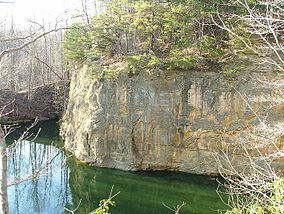Blackhand Gorge State Nature Preserve
| Blackhand Gorge State Nature Preserve | |
|---|---|
 |
|
| Location | Licking County, Ohio |
| Nearest city | Newark, Ohio |
| Coordinates | 40°03′22″N 82°14′54″W / 40.056°N 82.24847°WCoordinates: 40°03′22″N 82°14′54″W / 40.056°N 82.24847°W |
| Area | 957 acres (387 ha) |
| Established | 1975 |
| Governing body | Ohio Department of Natural Resources |
| http://naturepreserves.ohiodnr.gov/blackhandgorge | |
The Blackhand Gorge State Nature Preserve is a 4-mile-long (6.4 km) sandstone formation through which the Licking River flows in Licking County, Ohio, United States. Located 12 miles (19 km) east of Newark near the tiny town of Toboso, 957 acres (387 ha) along the gorge were designated an Ohio Nature Preserve in 1975. The gorge is a capsule of Ohio transportation history, having hosted canal boats, steam railroads, electric interurbans, and automobiles through the years. It is named for the black hand petroglyph that was found on the cliff face by the first settlers to the area. Black Hand Sandstone is a resistant rock that also forms the backbone of the Hocking Hills region.
From 13,000 BC to 400 AD the Early Native American Indians (including Hopewell Indians) lived in the area and visited the gorge. Beginning in the early 19th century, Anglo-European settlers used it as a transportation route through the hilly east-central Ohio landscape.
Legend of the Black Hand
One origin legend describes a contest set up between two suitors. The loser amputated his own hand in shame and threw it off one of the gorge's cliffs (possibly above the current location of the railroad tunnel), creating a hand-shaped mark on the rock.
For complete review of the Blackhand Gorge, including the legend of the Black Hand, see Blackhand Gorge: A Journey Through Time by Aaron Keirns. It was first published in 1995 by Little River Publishing.
The Blackhand Gorge was named after the Black Hand, a prehistoric petroglyph in the shape of a black hand with spread fingers and part of a wrist. One elongated finger supposedly pointed towards a nearby Indian mound. It is thought that the symbol meant that all tribes passing through the gorge on their way to the flint pits a few miles south must pass through in peace. The rock was destroyed in 1828 during the construction of the Ohio and Erie Canal. Other petroglyphs survived until 1890, many recorded by Dr. James Salisbury and his brother Charles, of Newark, who deposited their tracings and notes with the American Antiquarian Society in Massachusetts. Blasting for the electric interurban railway in 1890 removed the last traces of almost all prehistoric stone carving.
...
Wikipedia

